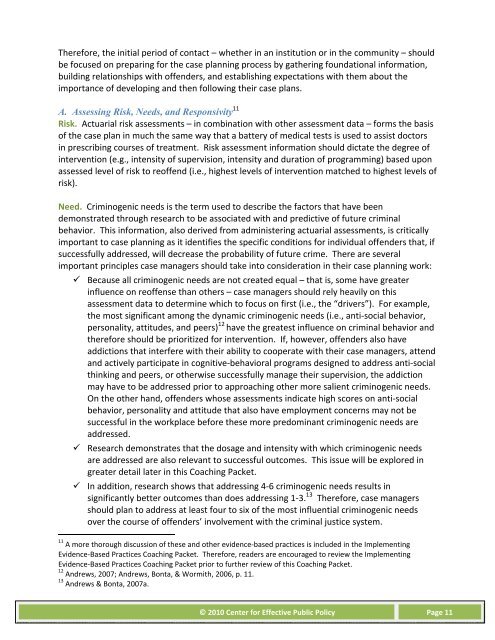COACHING PACKET Effective Case Management - The Center for ...
COACHING PACKET Effective Case Management - The Center for ...
COACHING PACKET Effective Case Management - The Center for ...
Create successful ePaper yourself
Turn your PDF publications into a flip-book with our unique Google optimized e-Paper software.
<strong>The</strong>re<strong>for</strong>e, the initial period of contact – whether in an institution or in the community – should<br />
be focused on preparing <strong>for</strong> the case planning process by gathering foundational in<strong>for</strong>mation,<br />
building relationships with offenders, and establishing expectations with them about the<br />
importance of developing and then following their case plans.<br />
A. Assessing Risk, Needs, and Responsivity 11<br />
Risk. Actuarial risk assessments – in combination with other assessment data – <strong>for</strong>ms the basis<br />
of the case plan in much the same way that a battery of medical tests is used to assist doctors<br />
in prescribing courses of treatment. Risk assessment in<strong>for</strong>mation should dictate the degree of<br />
intervention (e.g., intensity of supervision, intensity and duration of programming) based upon<br />
assessed level of risk to reoffend (i.e., highest levels of intervention matched to highest levels of<br />
risk).<br />
Need. Criminogenic needs is the term used to describe the factors that have been<br />
demonstrated through research to be associated with and predictive of future criminal<br />
behavior. This in<strong>for</strong>mation, also derived from administering actuarial assessments, is critically<br />
important to case planning as it identifies the specific conditions <strong>for</strong> individual offenders that, if<br />
successfully addressed, will decrease the probability of future crime. <strong>The</strong>re are several<br />
important principles case managers should take into consideration in their case planning work:<br />
ü Because all criminogenic needs are not created equal – that is, some have greater<br />
influence on reoffense than others – case managers should rely heavily on this<br />
assessment data to determine which to focus on first (i.e., the “drivers”). For example,<br />
the most significant among the dynamic criminogenic needs (i.e., anti-social behavior,<br />
personality, attitudes, and peers) 12 have the greatest influence on criminal behavior and<br />
there<strong>for</strong>e should be prioritized <strong>for</strong> intervention. If, however, offenders also have<br />
addictions that interfere with their ability to cooperate with their case managers, attend<br />
and actively participate in cognitive-behavioral programs designed to address anti-social<br />
thinking and peers, or otherwise successfully manage their supervision, the addiction<br />
may have to be addressed prior to approaching other more salient criminogenic needs.<br />
On the other hand, offenders whose assessments indicate high scores on anti-social<br />
behavior, personality and attitude that also have employment concerns may not be<br />
successful in the workplace be<strong>for</strong>e these more predominant criminogenic needs are<br />
addressed.<br />
ü Research demonstrates that the dosage and intensity with which criminogenic needs<br />
are addressed are also relevant to successful outcomes. This issue will be explored in<br />
greater detail later in this Coaching Packet.<br />
ü In addition, research shows that addressing 4-6 criminogenic needs results in<br />
significantly better outcomes than does addressing 1-3. 13 <strong>The</strong>re<strong>for</strong>e, case managers<br />
should plan to address at least four to six of the most influential criminogenic needs<br />
over the course of offenders’ involvement with the criminal justice system.<br />
11 A more thorough discussion of these and other evidence-based practices is included in the Implementing<br />
Evidence-Based Practices Coaching Packet. <strong>The</strong>re<strong>for</strong>e, readers are encouraged to review the Implementing<br />
Evidence-Based Practices Coaching Packet prior to further review of this Coaching Packet.<br />
12 Andrews, 2007; Andrews, Bonta, & Wormith, 2006, p. 11.<br />
13 Andrews & Bonta, 2007a.<br />
© 2010 <strong>Center</strong> <strong>for</strong> <strong>Effective</strong> Public Policy Page 11


